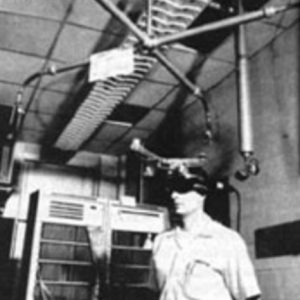aNewDomain — It’s funny. Fully 51 years have passed since graphics pioneer Ivan Sutherland first introduced the idea of VR to the world. But its holy grail — the creation of virtual experiences that are indistinguishable from reality — still eludes us.
 The problem, as Sutherland and other legendary VR pioneers have pointed out for years, isn’t so much about computing or graphics speed: It’s latency. Waiting even microseconds for responses that your brain tells you should be instant makes virtual reality a shadow of the real thing.
The problem, as Sutherland and other legendary VR pioneers have pointed out for years, isn’t so much about computing or graphics speed: It’s latency. Waiting even microseconds for responses that your brain tells you should be instant makes virtual reality a shadow of the real thing.
That’s why this week’s news around the Wi-Fi Alliance’s launch of a certification standard for the new WiFi Gigabit standard, called WiGig was such a big deal to AR and VR developers, investors and market watchers:
Not only is 80211ad blazingly fast, but it also boasts super low latency times.
The new certification standard is a major break for WiGig, a standard Intel and Qualcomm haven’t quite managed to drive forward till now. And for an AR and VR industry hungry for fast paced improvement in the quality of immersive experiences, the timing couldn’t be any better either.
Of course, there are general market benefits to WiGig, too. Rapid downloading is the one everyone wants to talk about most. With WiGig speeds, downloading a full Netflix MadMen episode should take just a couple of minutes. Enterprise and serious prosumers, too, will welcome WiGig as current 2.4GHz WiFi frequencies get increasingly clogged.
Reportedly there are dozens of WiGig devices, from mobile computing devices on down, due to announce or ship after CES 2017 in January. That explains why, just the day after the WiGig certification news came out on Monday, three analyst firms issued rosy outlooks for the standard: One, from Grand View Research, estimated the size of the WiGig market to hit $742 billion by 2024.
An untethered VR future
WiGig outperforms previous WiFi standards by a mile largely because it operates at such a high frequency, at 60GHz. That’s what enables it to send data at the rate of a gigabit per second or even faster, with throughput times top out at nearly 8Gb/second. That’s true even when connected to a single client device by shifting from the relatively congested 2.4GHz and 5GHz radio frequency spectrum up to the full 60GHz.
Bear in mind, though, high frequency transmissions don’t travel as far — and signals slow when they encounter walls, doors, furniture and other obstructions.
Still, you can expect a full range of mobile devices, laptops and all manner of consumer hardware to support WiGig by this time next year. They’ll look about the same as they ever did, only they’ll transmit and receive wireless data faster.
Head-mounted AR/VR displays could be in for a revolution.
WiGig absolutely will enable untethered, high-performance AR and VR experiences A computer or an AR/VR appliance in the room will generate high definition, low latency video that the user sees in a relatively “dumb,” light and comfortable headset or glasses and information from the headset and any controllers will be transmitted wirelessly back to the computer.
The untethered user will be free to move about the room and, since most of the computation will be off-loaded to the computer, the headset will not consume much power. Intel spoke about the possibilities around this earlier this year in its Project Alloy demonstrations around the Oculus Rift set, and those capabilities are just the beginning.
What’s funny is, sometimes to understand the possibilities of the future it is useful to look back. Take a look at the below short video showing Sutherland’s research prototype demonstration of a very slightly augmented reality back in the 1960s. I think it’s the best way to put the possibilities of untethered, high performance AR/VR in perspective.
In 1965, when Sutherland first delivered his prescient sci-fi vision of virtual reality, which he called the Ultimate Display, he described a future where a computer screen wasn’t a screen, but a window into another world — a window that, “with appropriate programming … could literally be the Wonderland into which Alice walked.”
In his vision, the untethered user was free to move about the room and, since most of the computation will be off-loaded to the computer, the headset would not consume much power. Pretty prescient.
Check out the original Ultimate Display paper that Sutherland delivered 51 years ago in New York. It’s embedded and readable in full below.
Ivan Sutherland’s Historic 1965 VR Talk: The Ultimate Display by Gina Smith on Scribd
Want to read more about the role latency plays in VR? Click here to read my colleague Gina Smith’s interview with him, Ivan Sutherland and other legendary tech pioneers and Turing Prize winners at the Heidelberg Laureate Forum 2016 earlier this fall.
And below, here’s a must-read: a classic 1990s-era paper penned by Brooks, which takes a long look at the big VR challenges ahead in tech, most of which still lie before us. Some good things just take awhile.
Fred Brooks Paper- What’s Real About Virtual Reality? by Gina Smith on Scribd
Cover image: VRS.org.uk, All Rights Reserved












